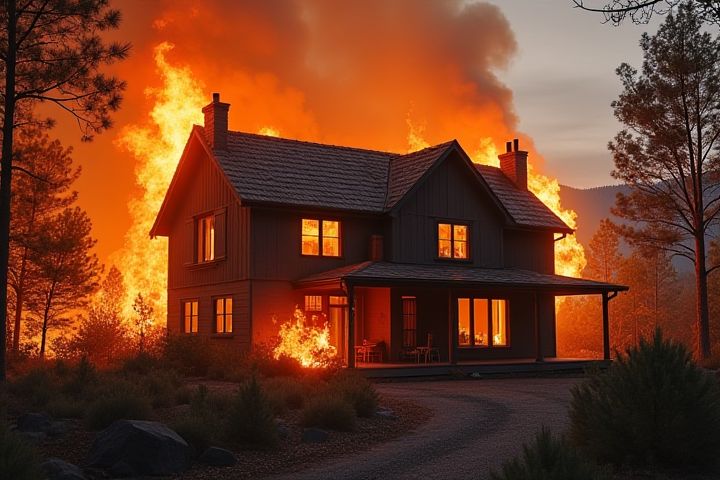
A house can survive a wildfire if it is strategically designed and constructed with fire-resistant materials. Features such as non-combustible roofing, tempered glass windows, and stucco or brick siding significantly enhance a home's resilience against flames. Surrounding vegetation should be carefully managed, with defensible space created by clearing flammable materials within a minimum of 30 feet around the property. Investing in fire-retardant landscaping can further reduce the risk of an approaching fire. You can increase your home's chances of surviving a wildfire by implementing these protective measures and conducting regular maintenance.
Can A House Survive Wildfire
Fire-resistant building materials
Incorporating fire-resistant building materials can significantly enhance a house's survivability during a wildfire. Options like stucco, brick, and fiber-cement siding provide excellent resistance to flames and heat, whereas metal roofing and tempered glass windows further protect against embers and intense temperatures. Additionally, non-combustible decking options and fire-rated doors can help shield critical areas of your home. Investing in these materials not only increases your home's resilience but can also lower insurance premiums and improve overall safety.
Defensible space
Creating a defensible space around your house is crucial for wildfire survival. The National Fire Protection Association recommends maintaining at least 30 feet of defensible space, where you remove combustible materials and vegetation. Use fire-resistant plants and hardscaping within this zone, as well as keeping grass trimmed to under 4 inches. Regular maintenance, such as clearing debris and ensuring proper spacing between trees and shrubs, can significantly enhance your home's resilience against wildfires.
Fire-resistant landscaping
Fire-resistant landscaping plays a crucial role in protecting your home from wildfires. Implementing native plants that are drought-resistant can reduce flammability while maintaining a beautiful aesthetic. Creating defensible space by removing highly flammable materials and using non-combustible hardscaping elements, such as stone pathways and gravel, significantly lowers the risk of fire spread. Incorporating fire-resistant trees and shrubs, spaced appropriately to limit fire transfer, contributes to a safer environment for your house during wildfire threats.
Ember-resistant vents
Ember-resistant vents are essential for protecting your home from wildfires, as they prevent embers from entering and igniting combustible materials inside. These specially designed vents have screens with small openings that block flying debris while allowing for proper ventilation. When you install ember-resistant vents, ensure they comply with the latest building codes and fire-resistant materials to enhance your home's overall safety. Regular maintenance and inspection of these vents will further reduce the risk of fire damage, safeguarding your property during wildfire events.
Fire-resistant roofing
Fire-resistant roofing is a critical component in enhancing a house's ability to withstand wildfires. Materials such as metal, clay tile, or asphalt shingles with a high fire rating can significantly reduce the risk of igniting from spark or flying embers. You should also consider maintaining a defensible space around your home, which includes clearing flammable vegetation and debris that could easily ignite. Investing in fire-resistant roofing not only protects your home but can also potentially lower insurance costs and increase property value in wildfire-prone areas.
Double-pane windows
Double-pane windows significantly enhance a house's chances of surviving a wildfire by providing improved insulation and fire resistance. The two layers of glass create an insulating barrier that reduces heat transfer, minimizing the risk of internal ignition from external flames. Many double-pane windows feature tempered glass, which can withstand higher temperatures up to 1,000degF compared to single-pane options. Installing double-pane windows can be a crucial step in wildfire-prone areas, as they not only improve energy efficiency but also bolster overall safety during fire events.
Fire-retardant coatings
Fire-retardant coatings significantly enhance a house's ability to survive wildfires by creating a protective barrier that slows down the spread of flames. These specialized coatings are made from non-combustible materials that can be applied to various surfaces, including wood, siding, and roofing, thereby reducing the risk of ignition. By absorbing heat and releasing flames, fire-retardant coatings help maintain the integrity of your home's structure, even in extreme conditions. Investing in these protective measures is essential for homeowners in wildfire-prone areas, as they can be a critical factor in safeguarding your property.
Gutter and roof maintenance
Regular gutter maintenance is crucial for wildfire preparedness, as clogged gutters can trap leaves and debris, creating a fire hazard. Cleaning your gutters at least twice a year can prevent the accumulation of flammable materials. Installing gutter guards can further enhance protection by keeping debris out while allowing water to flow freely. Ensuring your roof is made from fire-resistant materials, such as metal or asphalt shingles, and maintaining it by promptly repairing any damage can significantly improve your home's chances of surviving a wildfire.
Emergency evacuation plan
A robust emergency evacuation plan is crucial for your home's survival during a wildfire. Identify multiple escape routes from your property, ensuring that family members and pets are familiar with these paths. Assemble an emergency kit, including essential supplies like water, non-perishable food, medications, and important documents, to facilitate a quick getaway. Regularly practice evacuation drills to enhance preparedness, ensuring that everyone knows their roles and responsibilities when a wildfire threatens your area.
Community fire mitigation programs
Community fire mitigation programs play a crucial role in enhancing the resilience of homes against wildfires. Implementing strategies such as creating defensible space, utilizing fire-resistant building materials, and employing prescribed burns can significantly reduce the risk of fire damage. Studies show that properties within a 100-foot buffer zone that adheres to mitigation guidelines have a 50% higher survival rate during wildfires. By participating in local initiatives, you can help strengthen your community's overall fire preparedness and protect your home effectively.
